From the frequency of attacks to the scope of ambition, racist terror groups – encouraged by the president, are showing unparalleled activity in the modern era

A militia group, including Pete Musico, right, who was charged over a plot to kidnap the Michigan governor, stands in front of the governor’s office after protesters occupied the state capitol building in Lansing, Michigan, on 30 April 2020. Photograph: Seth Herald/Reuters
Ed Pilkington
Mon 19 Oct 2020
On 6 October Chad Wolf, the acting secretary of homeland security, released his department’s annual assessment of violent threats to the nation. Analysts didn’t have to dig deep into the assessment to discover its alarming content.
In a foreword, Wolf wrote that he was “particularly concerned about white supremacist violent extremists who have been exceptionally lethal in their abhorrent, targeted attacks in recent years. [They] seek to force ideological change in the United States through violence, death, and destruction.”

Gretchen Whitmer: Trump 'inciting domestic terrorism' with 'Lock her up!' rally chant
Two days later, the FBI swooped. It arrested 13 rightwing extremists who had allegedly been plotting to carry out a range of attacks in Michigan, including the kidnapping of the Democratic governor, Gretchen Whitmer.
Later revelations revealed that a group of anti-government paramilitaries that included some of those arrested had also discussed kidnapping the governor of Virginia.
The double strike, just days apart, of the threat assessment and the Michigan plot arrests marked an important moment in America’s tortured history of racist terrorism. US authorities appeared not only to have woken up finally to the extent of the white supremacist threat but were actually doing something about it.
As the FBI director, Christopher Wray, told Congress in February, “racially and ethnically motivated violent extremists” have become the “primary source of ideologically motivated lethal incidents” in the US. The danger overshadowed the jihadist threat that has dominated the security debate since 9/11.
Last year was the deadliest on record for domestic extremist violence since the Oklahoma City bombing of 1995. White supremacists were responsible for most of that bloodshed in 2019 – 39 out of 48 deaths, including 23 people who died at the hands of an anti-Hispanic racist in El Paso, Texas, and a Jewish worshipper murdered at Poway Synagogue in California.
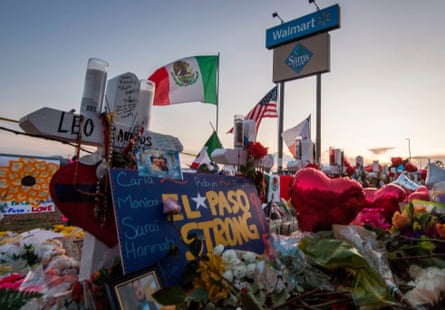
Ed Pilkington
Mon 19 Oct 2020
On 6 October Chad Wolf, the acting secretary of homeland security, released his department’s annual assessment of violent threats to the nation. Analysts didn’t have to dig deep into the assessment to discover its alarming content.
In a foreword, Wolf wrote that he was “particularly concerned about white supremacist violent extremists who have been exceptionally lethal in their abhorrent, targeted attacks in recent years. [They] seek to force ideological change in the United States through violence, death, and destruction.”

Gretchen Whitmer: Trump 'inciting domestic terrorism' with 'Lock her up!' rally chant
Two days later, the FBI swooped. It arrested 13 rightwing extremists who had allegedly been plotting to carry out a range of attacks in Michigan, including the kidnapping of the Democratic governor, Gretchen Whitmer.
Later revelations revealed that a group of anti-government paramilitaries that included some of those arrested had also discussed kidnapping the governor of Virginia.
The double strike, just days apart, of the threat assessment and the Michigan plot arrests marked an important moment in America’s tortured history of racist terrorism. US authorities appeared not only to have woken up finally to the extent of the white supremacist threat but were actually doing something about it.
As the FBI director, Christopher Wray, told Congress in February, “racially and ethnically motivated violent extremists” have become the “primary source of ideologically motivated lethal incidents” in the US. The danger overshadowed the jihadist threat that has dominated the security debate since 9/11.
Last year was the deadliest on record for domestic extremist violence since the Oklahoma City bombing of 1995. White supremacists were responsible for most of that bloodshed in 2019 – 39 out of 48 deaths, including 23 people who died at the hands of an anti-Hispanic racist in El Paso, Texas, and a Jewish worshipper murdered at Poway Synagogue in California.

The makeshift memorial for victims of the shooting at the Cielo Vista Mall Walmart in El Paso, Texas, on 6 August 2019. Photograph: Mark Ralston/AFP/Getty Images
While federal authorities may be showing a new resolve to tackle the problem, experts on white supremacy warn that the extremists are showing even greater determination. The movement is stirring, nationwide.
“The threat is serious and intense,” said Vanda Felbab-Brown, a terrorism and extremism expert at Brookings. “It is by far the most serious domestic danger in the US on many levels – the frequency of attacks, the level of recruitment, the scope of ambition of the groups and the wider political capital they are building.”
If 2019 was the deadliest year in a quarter of a century for domestic terrorism in America, 2020 is shaping up to be the year that white supremacy spreads its wings. Groups are showing a degree of confidence unparalleled in the modern era.
Agitators have seized the dual opportunities of the coronavirus pandemic and the Black Lives Matter protests to come out of the shadows and on to the streets. Even before the start of the pandemic, they were flexing their muscles.
Felbab-Brown recalls attending the gun rally in Richmond, Virginia, in January that attracted thousands of extremists carrying semi-automatic assault rifles. “There were militia members from all across the US, Trump supporters with guns, gun rights supporters, all mixing together in large crowds. They drew energy from each other, enlarged their networks and emboldened their thinking – and that was before Covid.”
Since the pandemic struck in late January, the rightwing surge has gathered pace. Armed groups of extremists have presented themselves as vigilante security guards, ostensibly protecting property during anti-police brutality protests but in reality confronting peaceful protesters and sowing chaos and violence that has culminated in loss of life.
Though studies have noted the rise of far-right violence in the US as far back as 2007, there is one aspect of today’s political climate that makes the current threat level uniquely dangerous: Donald Trump. In the recent presidential debate with Joe Biden he notoriously declined to denounce the extremist group the Proud Boys, exhorting them to “stand back and stand by”.
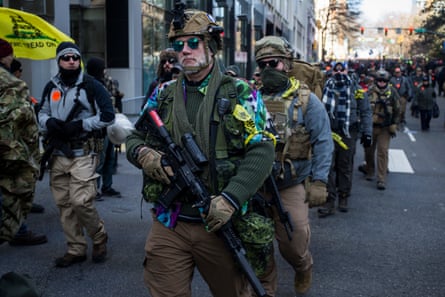
While federal authorities may be showing a new resolve to tackle the problem, experts on white supremacy warn that the extremists are showing even greater determination. The movement is stirring, nationwide.
“The threat is serious and intense,” said Vanda Felbab-Brown, a terrorism and extremism expert at Brookings. “It is by far the most serious domestic danger in the US on many levels – the frequency of attacks, the level of recruitment, the scope of ambition of the groups and the wider political capital they are building.”
If 2019 was the deadliest year in a quarter of a century for domestic terrorism in America, 2020 is shaping up to be the year that white supremacy spreads its wings. Groups are showing a degree of confidence unparalleled in the modern era.
Agitators have seized the dual opportunities of the coronavirus pandemic and the Black Lives Matter protests to come out of the shadows and on to the streets. Even before the start of the pandemic, they were flexing their muscles.
Felbab-Brown recalls attending the gun rally in Richmond, Virginia, in January that attracted thousands of extremists carrying semi-automatic assault rifles. “There were militia members from all across the US, Trump supporters with guns, gun rights supporters, all mixing together in large crowds. They drew energy from each other, enlarged their networks and emboldened their thinking – and that was before Covid.”
Since the pandemic struck in late January, the rightwing surge has gathered pace. Armed groups of extremists have presented themselves as vigilante security guards, ostensibly protecting property during anti-police brutality protests but in reality confronting peaceful protesters and sowing chaos and violence that has culminated in loss of life.
Though studies have noted the rise of far-right violence in the US as far back as 2007, there is one aspect of today’s political climate that makes the current threat level uniquely dangerous: Donald Trump. In the recent presidential debate with Joe Biden he notoriously declined to denounce the extremist group the Proud Boys, exhorting them to “stand back and stand by”.

Gun rights advocates attend a rally organized by The Virginia Citizens Defense League near the state capitol building on 20 January in Richmond, Virginia.
Photograph: Zach Gibson/Getty Images
Trump has done far more than refuse to criticize white supremacist groups – he has actively communicated with them through his Twitter feed and dog-whistles blown on the campaign trail. “He may not be talking to them in person, but he definitely is talking to them through the frequency,” Felbab-Brown said.
Trump has issued calls to arms to domestic terrorist groups during pandemic lockdowns in Democratic-controlled states. In April his cry of “Liberate Michigan!” was interpreted by militant groups as an invitation to storm the state capitol with their weapons.
His incendiary “law and order” posture in the wake of largely peaceful protests has had similar effect, as did his defence of Kyle Rittenhouse, the white teenager charged with killing two people amid anti-police brutality protests in Kenosha, Wisconsin.
On Thursday, and again over the weekend at his rallies, Trump returned to the theme of the enabling of extremists during the NBC town hall in which he effectively endorsed the toxic pedophilia conspiracy theory espoused by QAnon, the rightwing movement identified by the FBI as a potential domestic terrorism threat. The president also renewed his attacks on Whitmer – an astonishingly rash act given the terrorist plots against the Michigan governor.
“Trump’s messages to the groups have been egregious and disastrous, on a par with the behavior of Jair Bolsonaro of Brazil and Rodrigo Duterte of the Philippines,” Felbab-Brown said. “They have been enormously harmful to the US.”
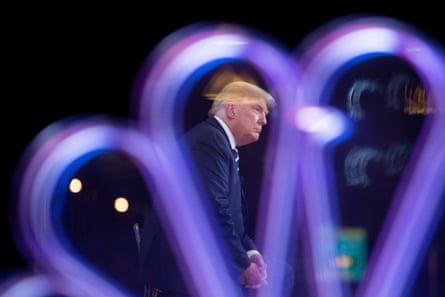
Trump has done far more than refuse to criticize white supremacist groups – he has actively communicated with them through his Twitter feed and dog-whistles blown on the campaign trail. “He may not be talking to them in person, but he definitely is talking to them through the frequency,” Felbab-Brown said.
Trump has issued calls to arms to domestic terrorist groups during pandemic lockdowns in Democratic-controlled states. In April his cry of “Liberate Michigan!” was interpreted by militant groups as an invitation to storm the state capitol with their weapons.
His incendiary “law and order” posture in the wake of largely peaceful protests has had similar effect, as did his defence of Kyle Rittenhouse, the white teenager charged with killing two people amid anti-police brutality protests in Kenosha, Wisconsin.
On Thursday, and again over the weekend at his rallies, Trump returned to the theme of the enabling of extremists during the NBC town hall in which he effectively endorsed the toxic pedophilia conspiracy theory espoused by QAnon, the rightwing movement identified by the FBI as a potential domestic terrorism threat. The president also renewed his attacks on Whitmer – an astonishingly rash act given the terrorist plots against the Michigan governor.
“Trump’s messages to the groups have been egregious and disastrous, on a par with the behavior of Jair Bolsonaro of Brazil and Rodrigo Duterte of the Philippines,” Felbab-Brown said. “They have been enormously harmful to the US.”

Donald Trump participates in an NBC News town hall event at the Perez Art Museum in Miami on 15 October. Photograph: Brendan Smialowski/AFP/Getty Images
Michael German, a fellow of the Brennan Center for Justice who worked in the 1990s as an undercover FBI agent infiltrating white supremacist and militia groups, has studied how Trump’s racist appeals and implicit encouragement of violence have played with far-right militants. “Now they feel sanctioned. They think, ‘my violence is no longer criminal, it’s allowed, it’s what the president wants us to do’,” he said.
German has watched too as the groups have grown more methodical and practiced in their tactics over the past four years of Trump approbation. The tacit approval they have received from the Trump administration has rendered them far more effective and dangerous.
“As an undercover agent, I was present in the room when militants tried to convince a recruit to carry out a violent act and either go to the grave or become a fugitive. That’s a hard hump to get over. If you feel the president of the United States has authorized you to engage in this activity, it’s a lot easier.”
With white supremacy showing a new vitality, German is skeptical that the FBI and the Department of Homeland Security are serious about taking on the threat. The recent acknowledgments of the extent of the danger from Wolf and Wray are a step in the right direction, but much more urgency is needed.
“I want to see it in data. I want to see the arrests, the investigations, I want to know what the FBI is actually doing. I suspect the data would show that there have been a lot of deaths caused by white supremacists, but disproportionately few investigations,” German said.
The FBI’s use of resources tells its own story. The agency divides its counter-terrorism pie up 80 to 20: 80% goes on fighting international terrorism, 20% domestic.
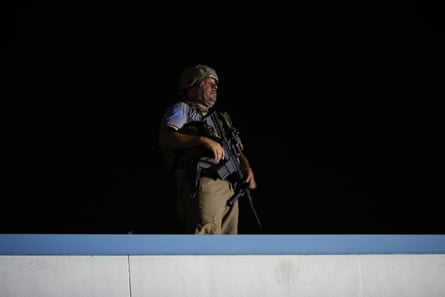
Michael German, a fellow of the Brennan Center for Justice who worked in the 1990s as an undercover FBI agent infiltrating white supremacist and militia groups, has studied how Trump’s racist appeals and implicit encouragement of violence have played with far-right militants. “Now they feel sanctioned. They think, ‘my violence is no longer criminal, it’s allowed, it’s what the president wants us to do’,” he said.
German has watched too as the groups have grown more methodical and practiced in their tactics over the past four years of Trump approbation. The tacit approval they have received from the Trump administration has rendered them far more effective and dangerous.
“As an undercover agent, I was present in the room when militants tried to convince a recruit to carry out a violent act and either go to the grave or become a fugitive. That’s a hard hump to get over. If you feel the president of the United States has authorized you to engage in this activity, it’s a lot easier.”
With white supremacy showing a new vitality, German is skeptical that the FBI and the Department of Homeland Security are serious about taking on the threat. The recent acknowledgments of the extent of the danger from Wolf and Wray are a step in the right direction, but much more urgency is needed.
“I want to see it in data. I want to see the arrests, the investigations, I want to know what the FBI is actually doing. I suspect the data would show that there have been a lot of deaths caused by white supremacists, but disproportionately few investigations,” German said.
The FBI’s use of resources tells its own story. The agency divides its counter-terrorism pie up 80 to 20: 80% goes on fighting international terrorism, 20% domestic.

An armed civilian stands on a roof during protests on 25 August over the shooting of Jacob Blake by a police officer in Kenosha, Wisconsin.
Photograph: Tayfun CoskunAnadolu Agency/via Getty Images
The bureau’s own figures compiled for 2008 to 2018 indicate that the balance of threat is the exact reverse – some 73% of all extremist murders in the US in that period were by far-right terrorists, only 23% by Islamist terrorists.
At least at the federal level, the FBI is having some success in infiltrating extremist groups as the arrests of the alleged Michigan kidnap plotters attested. The record among state and local law enforcement looks far less impressive.
Among local police forces, the pattern is less likely to be infiltration of far-right groups by officers than the other way round – extremists are inveigling themselves into police forces. German’s work for the Brennan Center, drawing on FBI policy documents, has pointed out that white supremacist and anti-government groups often have “active links” with law enforcement officials.
Yet the justice department has no national strategy for spotting and removing white supremacist police officers.
On Thursday, armed members of the Boogaloo Bois – extremists agitating for a second civil war – illegally assembled outside the police headquarters in Newport News, Virginia. Instead of arresting the men for violating a ban on firearms on city property, the police chief handed their leader a bottle of chocolate milk and allowed him to address his ranks through a microphone and sound system that the force provided.
An insight into the world that is being created by this heady combination of a supportive president and fraternizing local police amid the turmoil of the pandemic and a fast-approaching volatile election is afforded by a new podcast from the Southern Poverty Law Center. Baseless takes listeners inside the leadership of the Base, a domestic terror group dedicated to destroying US democracy and sparking a race war that they believe and hope will transform America into a white ethno-state.
Drawing on 83 hours of secret recordings of top leaders inside the Base, including its founder Rinaldo Nazzaro whose true identity was revealed by the Guardian in January, the podcast conveys with chilling intimacy the scale of the white supremacists’ ambitions.
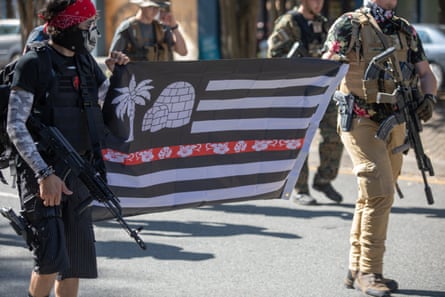
The bureau’s own figures compiled for 2008 to 2018 indicate that the balance of threat is the exact reverse – some 73% of all extremist murders in the US in that period were by far-right terrorists, only 23% by Islamist terrorists.
At least at the federal level, the FBI is having some success in infiltrating extremist groups as the arrests of the alleged Michigan kidnap plotters attested. The record among state and local law enforcement looks far less impressive.
Among local police forces, the pattern is less likely to be infiltration of far-right groups by officers than the other way round – extremists are inveigling themselves into police forces. German’s work for the Brennan Center, drawing on FBI policy documents, has pointed out that white supremacist and anti-government groups often have “active links” with law enforcement officials.
Yet the justice department has no national strategy for spotting and removing white supremacist police officers.
On Thursday, armed members of the Boogaloo Bois – extremists agitating for a second civil war – illegally assembled outside the police headquarters in Newport News, Virginia. Instead of arresting the men for violating a ban on firearms on city property, the police chief handed their leader a bottle of chocolate milk and allowed him to address his ranks through a microphone and sound system that the force provided.
An insight into the world that is being created by this heady combination of a supportive president and fraternizing local police amid the turmoil of the pandemic and a fast-approaching volatile election is afforded by a new podcast from the Southern Poverty Law Center. Baseless takes listeners inside the leadership of the Base, a domestic terror group dedicated to destroying US democracy and sparking a race war that they believe and hope will transform America into a white ethno-state.
Drawing on 83 hours of secret recordings of top leaders inside the Base, including its founder Rinaldo Nazzaro whose true identity was revealed by the Guardian in January, the podcast conveys with chilling intimacy the scale of the white supremacists’ ambitions.

Armed Boogaloo Boy protesters led by Mike Dunn holding a banner during a demonstration against new firearm restrictions.
Photograph: Chad Martin/Sopa Images/LightRocket via Getty Images
The militants describe the intricate vetting process that they follow for all new recruits. Potential new members are required to fill out a questionnaire that asks them whether they have had any military training.
Promising applicants are then invited into the “vetting room” in which a panel of five or six Base extremists, headed by Nazzaro, quiz them through an encrypted phone app. If they pass that stage, they are then given a task such as posting flyers around schools and college campuses that say “Save your race, join the Base”; and “Learn, train, fight, organize”.
The Base perceives itself not so much as an organization, but as a web of like-minded violent extremists. “We see ourselves more of a network,” Nazzaro is heard saying on the tapes.
But the one quality above all others that the terrorists crave is military experience. One in five of the 100 individuals who make an appearance on the recordings have had combat training as former or serving military personnel.
“This is a clear target,” said Jamila Paksima, co-producer of the Baseless podcast. “They are looking for people with military experience who can then train other recruits. So the US government is equipping people with the skills of warfare that are then potentially being turned back against the American people.”
The militants describe the intricate vetting process that they follow for all new recruits. Potential new members are required to fill out a questionnaire that asks them whether they have had any military training.
Promising applicants are then invited into the “vetting room” in which a panel of five or six Base extremists, headed by Nazzaro, quiz them through an encrypted phone app. If they pass that stage, they are then given a task such as posting flyers around schools and college campuses that say “Save your race, join the Base”; and “Learn, train, fight, organize”.
The Base perceives itself not so much as an organization, but as a web of like-minded violent extremists. “We see ourselves more of a network,” Nazzaro is heard saying on the tapes.
But the one quality above all others that the terrorists crave is military experience. One in five of the 100 individuals who make an appearance on the recordings have had combat training as former or serving military personnel.
“This is a clear target,” said Jamila Paksima, co-producer of the Baseless podcast. “They are looking for people with military experience who can then train other recruits. So the US government is equipping people with the skills of warfare that are then potentially being turned back against the American people.”
No comments:
Post a Comment